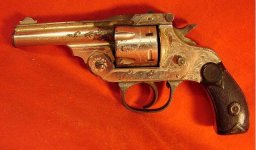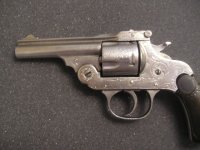Magnum Wheel Man
New member
a while back I bought an engraved 38 S&W Secret Service Special, that the seller said was made by Iver Johnson ( I have a 32 SSS, that was made by Iver, but I understand these were made by various companys, often of very marginal quality, for one guy who sold them under that name ) after looking over the gun after I recieved it, I'm pretty sure it's not an Iver Johnson... & I am / was assuming it was Spanish made... however I'm watching a Meriden 38 top break right now, & while looking over the pictures, I'm seeing alot of similarities to my SSS... I'm curious now if Meriden could have made my SSS, or if Meriden imported Spanish guns with their name on them... the gun functions fine, albeit a bit loosely, & has a nyloc nut on the safety ( most of the SSS had safetys ) which I'll probably have to machine a part that matches the one on my 32
here is a pic of my SSS ( I bought it very cheaply, because of the condition, & am looking at doing some resto work on it )... note the crown shaped front sight, & how the cylinder attaches, which are not Iver Johnson traights... the Meriden Revolver I'm looking at shares those traights so if this was made in Spain, then likely the other Meriden was as well ??? or it's possible my assumption that my SSS was Spanish made was wrong, & it was made by Meriden ??? so far, I don't have any Meriden revolvers, & don't know any company history

here is a pic of my SSS ( I bought it very cheaply, because of the condition, & am looking at doing some resto work on it )... note the crown shaped front sight, & how the cylinder attaches, which are not Iver Johnson traights... the Meriden Revolver I'm looking at shares those traights so if this was made in Spain, then likely the other Meriden was as well ??? or it's possible my assumption that my SSS was Spanish made was wrong, & it was made by Meriden ??? so far, I don't have any Meriden revolvers, & don't know any company history
Attachments
Last edited:


